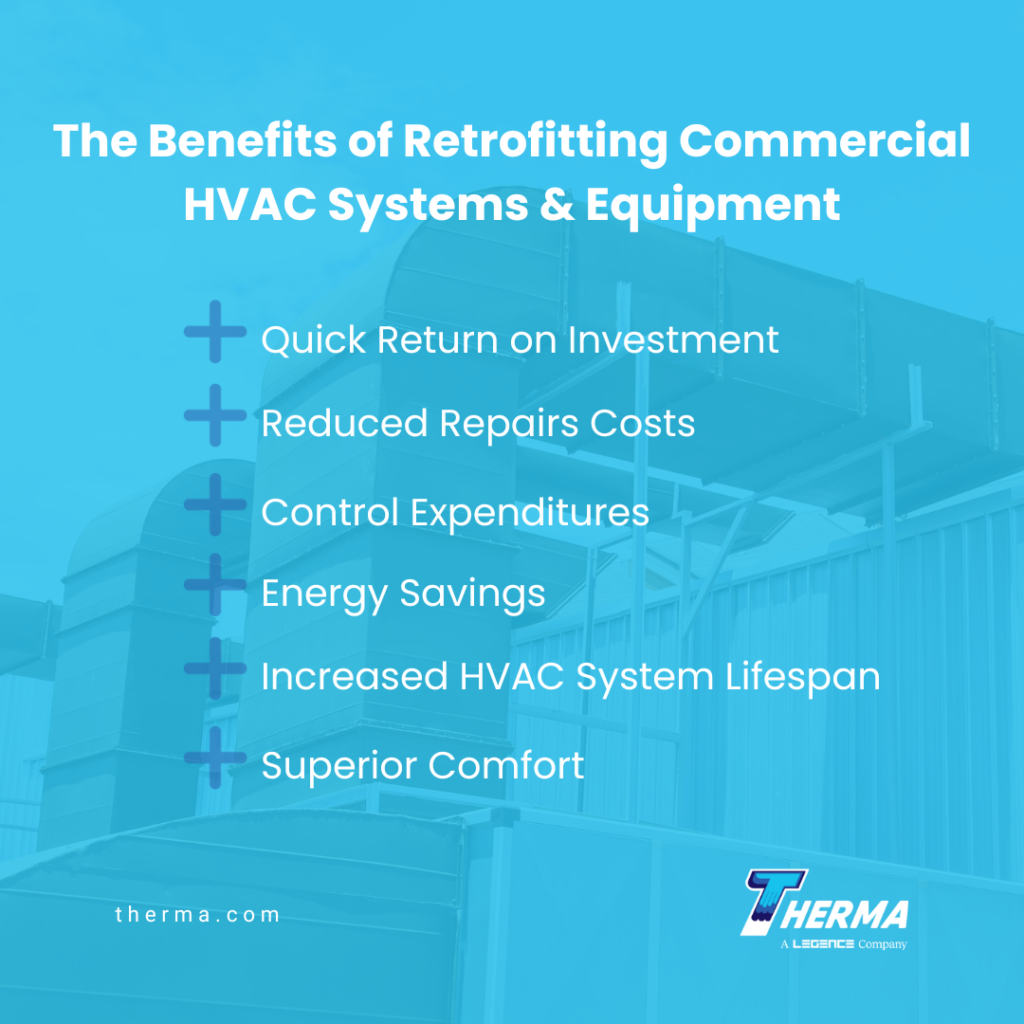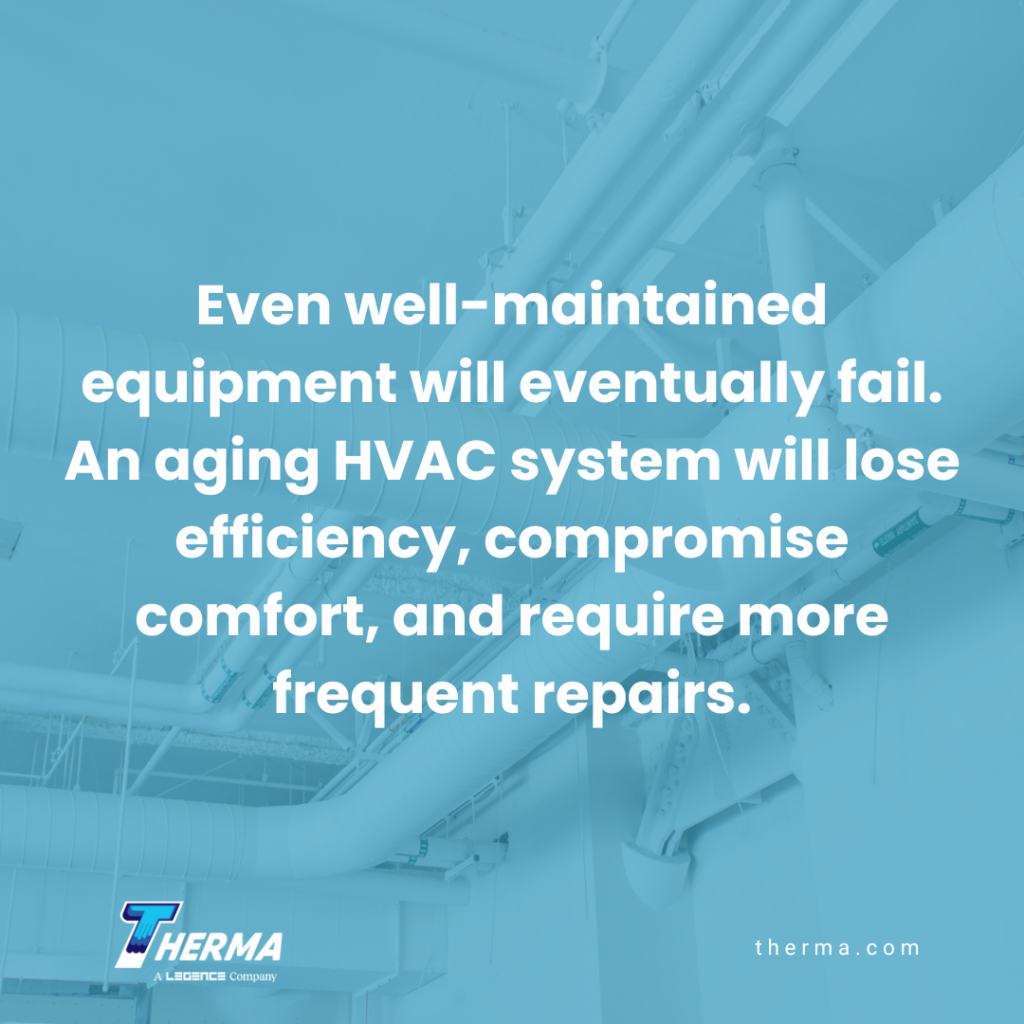Retrofit HVAC projects are designed to integrate new components into existing HVAC networks. When practical, retrofitting an HVAC system provides a more cost-effective way to improve performance without having to replace every piece of equipment.
When a Commercial HVAC Retrofit Makes Sense
Even well-maintained equipment will eventually fail. Most commercial heating and cooling systems have a functional service life of 15-30 years, depending on the brand and style of equipment. An aging HVAC system will lose efficiency, compromise comfort, and require more frequent repairs.
As HVAC maintenance becomes more expensive and time-consuming, decisions on how to restore lost performance come down to repair, retrofit, or replace. Replacing an entire commercial HVAC system can be costly and disruptive, and if the process isn’t planned properly, revenue and employee productivity can suffer. When repairs no longer provide necessary results and replacing the entire system is out of the question, retrofitting may be the best approach.
If your building experiences any of the following issues, it may be time for a retrofit upgrade:
- Is the HVAC system over 10 years old?
- Are energy bills escalating without a logical explanation?
- Do building occupants lodge comfort complaints?
- Are repair costs continually rising?
- Has the building developed an indoor air quality problem?
Common Commercial HVAC Retrofit Upgrades
A commercial HVAC retrofit helps solve problems caused by poor air movement, fluctuating temperatures in different zones, and high humidity. Even small changes like sealing the ductwork and adding economizers can make a significant difference in performance. Examples of commercial retrofit services offered by qualified and certified commercial HVAC contractors include:
- Airside economizer installation
- Ductwork sealing or replacement
- Replacement of semi-hermetic reciprocating compressors with high-efficiency screw compressors
- Adding condenser fan controls that incorporate variable-frequency drive operation
- Adding demand-controlled ventilation
- Installing supply fan speed controls
- Installing cooling capacity controls
- Adding smart temperature and humidity controls
- Installing CO2 sensors
HVAC commercial retrofit options largely depend on the type of heating and cooling equipment currently installed. Package rooftop units, boilers, and chillers are typically the best candidates for the retrofit process.
The Benefits of Retrofitting Commercial HVAC Systems and Equipment
A well-planned HVAC retrofit strategy results in a range of positive outcomes, from energy and cost savings to more productive occupants.
- Quick Return on Investment: Retrofitting is usually a fraction of the cost of investing in new equipment.
- Reduced Repairs Costs: HVAC repairs are expensive, but the hidden costs are far more devastating. Unexpected downtime can affect sales, revenues, customer satisfaction, and employee productivity.
- Control Expenditures: An unanticipated HVAC equipment breakdown can play havoc with departmental budgets. By planning heating and cooling upgrades and maintenance, costs become controlled and predictable, which can save money and help relieve stress and anxiety.
- Energy Savings: Many HVAC commercial retrofits are motivated by a desire to increase system efficiency. An HVAC retrofit can reduce energy use by 30 percent which also leads to lower costs.
- Increased HVAC System Lifespan: Lowering the number of HVAC equipment run cycles will reduce wear and tear on vital components. Ultimately, replacing worn parts and making strategic upgrades can enhance the lifecycle of the entire system.
- Superior Comfort: An optimized HVAC system runs more efficiently, but occupants will also enjoy better humidity control and more consistent temperatures throughout the building. In many cases, drafts and stale air pockets are eliminated, and even nuisance noise can be reduced.
Retrofitting commercial HVAC equipment is a relatively inexpensive way to improve the comfort, health, and safety of your building. In many cases, the savings on monthly fuel and power costs can pay back the investment in a relatively short time. Therma has extensive experience in designing, installing, and maintaining complex commercial heating and cooling systems and can help with the retrofit process.
Source and Additional Reading
EPA.gov – An Office Building Occupants Guide to Indoor Air Quality | US EPA
Energy.gov – HVAC Retrofit | Department of Energy
Facility Executive – The HVAC Factor: Best Practices For HVAC Retrofits That Deliver
Pacific Northwest National Laboratory – Energy Savings and Economics of Advanced Control Strategies for Packaged Air-Conditioning Units with Gas Heat
Energystar.gov – Evaluate the Economics of Energy Efficiency Projects









